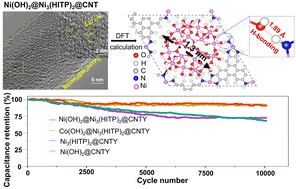Transition metal hydroxides@conducting MOFs on carbon nanotube yarns for ultra-stable quasi-solid-state supercapacitors with a ship-in-a-bottle architecture†
Abstract
Yarn-shaped supercapacitors (SCs) functionalized with pseudocapacitive materials show promise in wearable electronics. However, their development was hindered by poor electrochemical properties, especially long-term cycling stability, owing to the volumetric change during charging/discharging. Herein, we report a ship-in-a-bottle architecture on carbon nanotube yarn (CNTY) based SCs, in which transition metal hydroxide (TMH) nanoparticles (Ni(OH)2 or Co(OH)2) are confined in conducting nanoporous metal–organic frameworks (MOFs, Ni3(HITP)2) which anchor onto CNTY, involves the synergy of nanoconfinement and hydrogen bonding (H-bonding) network to mutually support each phase toward improved electrochemical performance. The Ni(OH)2@Ni3(HITP)2@CNTY electrode possesses an areal specific capacitance of 496 mF cm−2 at 0.4 mA cm−2 due to the hierarchical structure which led to facilitated charge transport and enhanced ion storage. Moreover, the ternary CNTY-based SCs demonstrate exceptional cycle performance (90.9–92.3% capacitance retention after 10 000 cycles at 5 mA cm−2). Importantly, the nanoconfinement is confirmed by field emission scanning electron microscopy, transmission electron microscopy-energy dispersive spectroscopy, and energy dispersive spectroscopy, and Brunauer–Emmett–Teller and cryogenic-TEM characterization studies. The H-bonding (O⋯H–N) network between Ni(OH)2 and Ni3(HITP)2 is confirmed by Fourier transform infrared spectroscopy and density functional theory calculations. Both nanoconfinement and the H-bonding network contribute to an ultra-stable Ni(OH)2@Ni3(HITP)2 structure due to its high durability to volumetric change caused by phase separation and structural collapse during charging/discharging.



 Please wait while we load your content...
Please wait while we load your content...